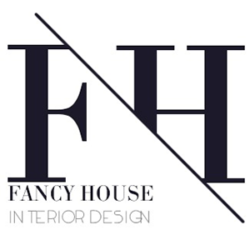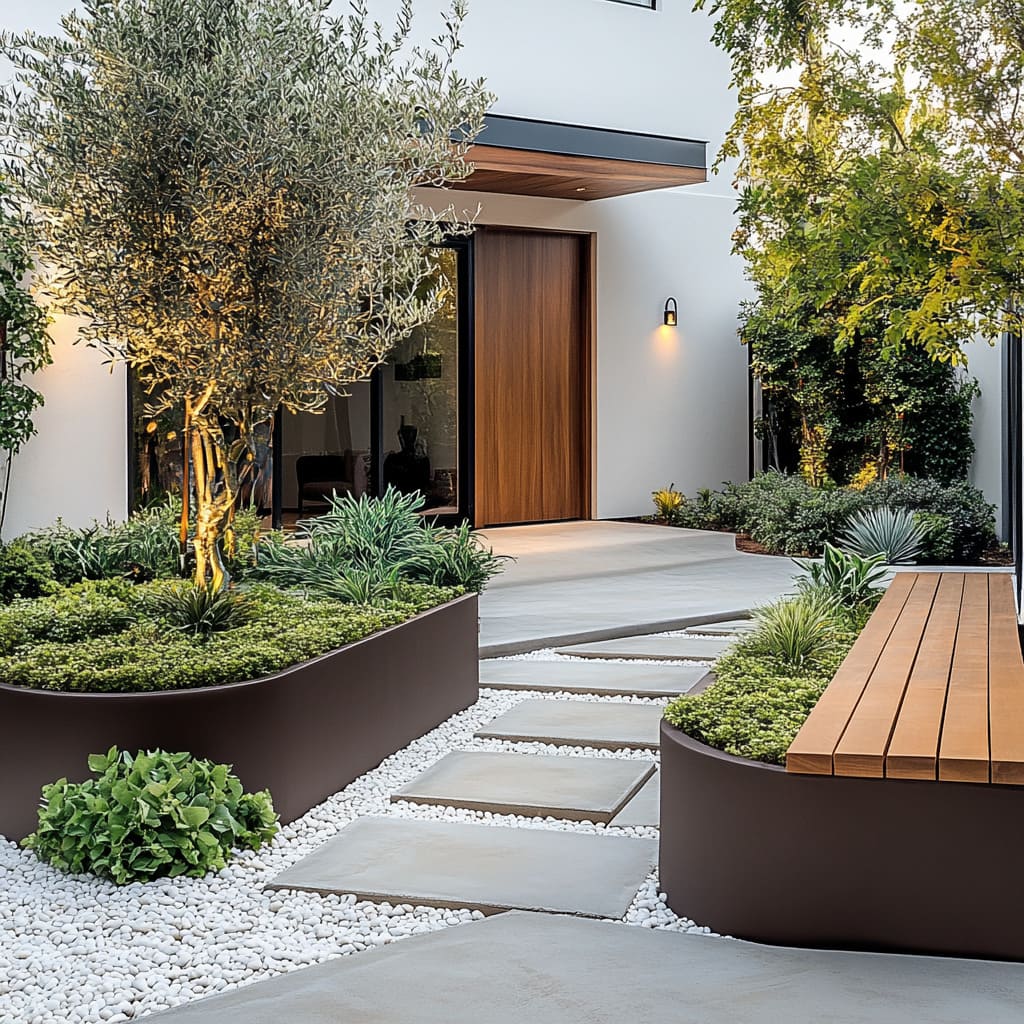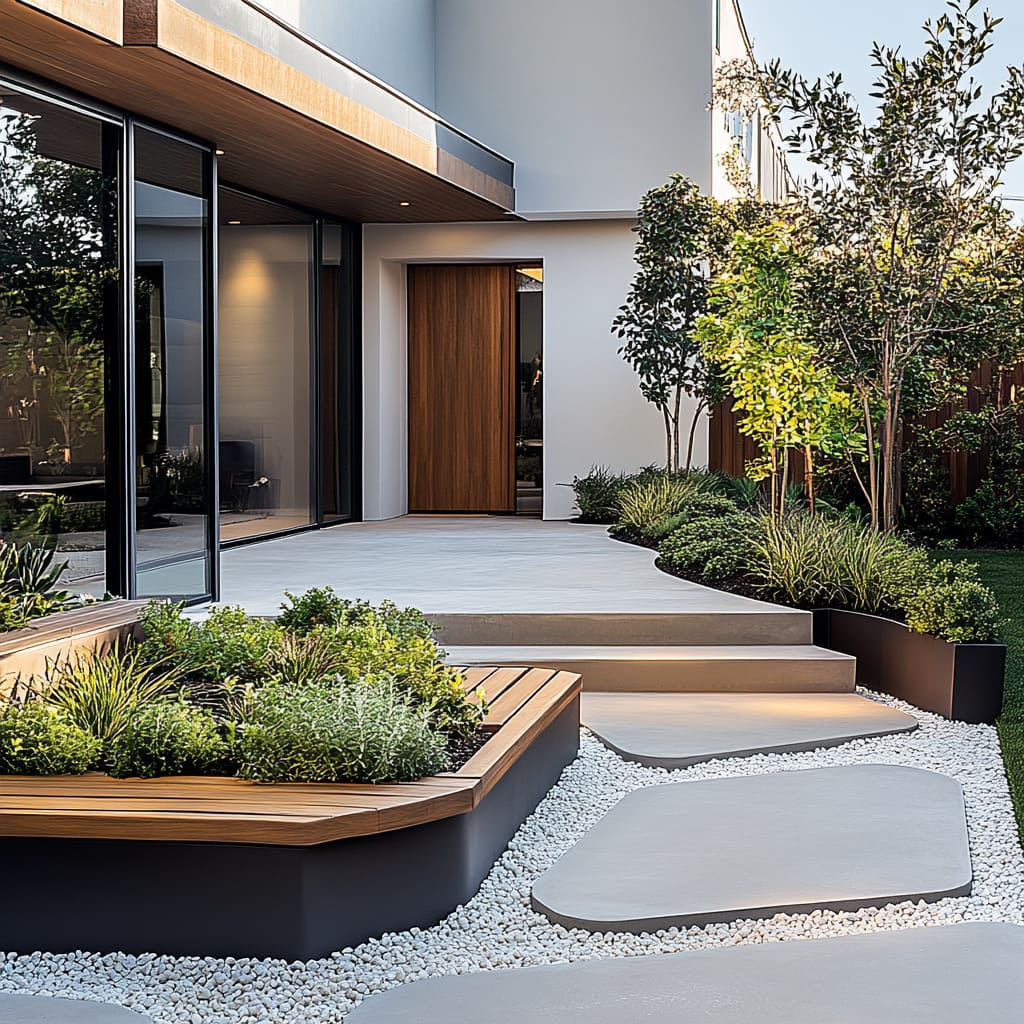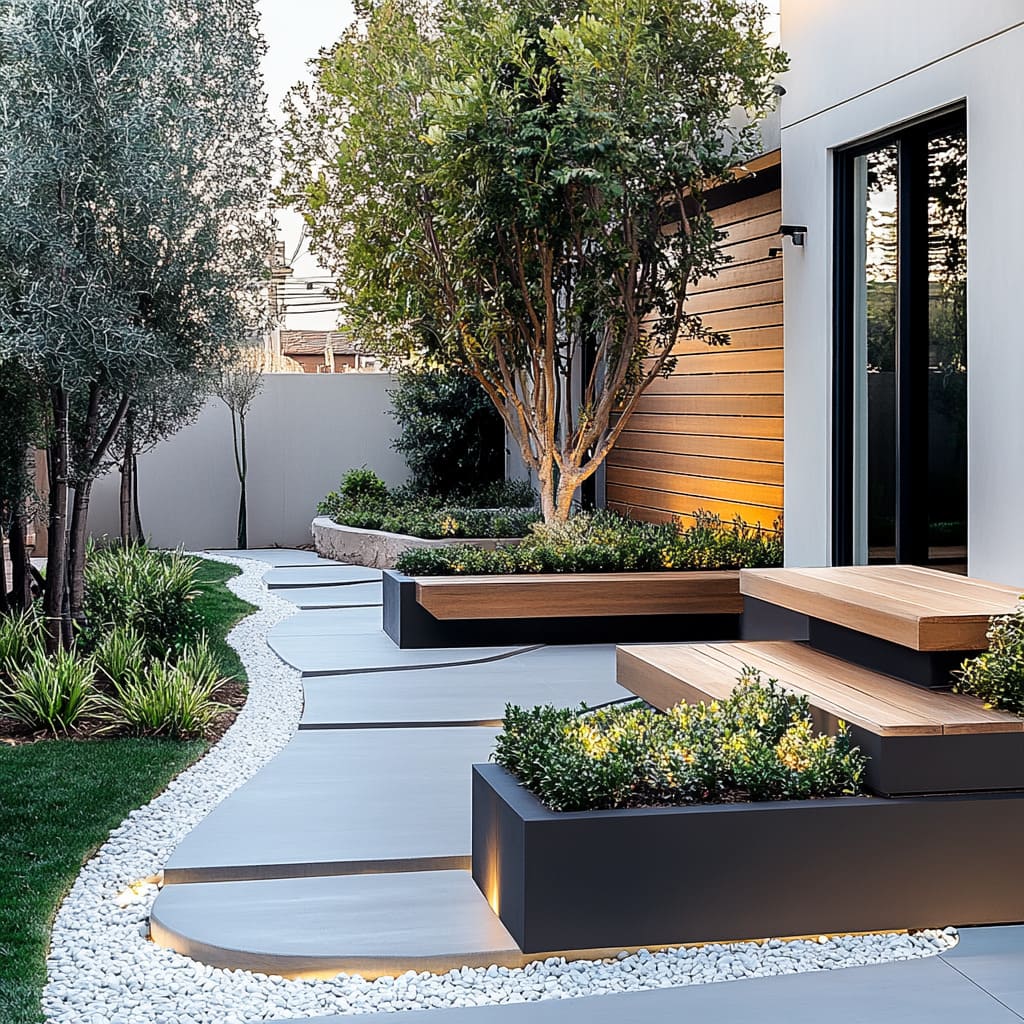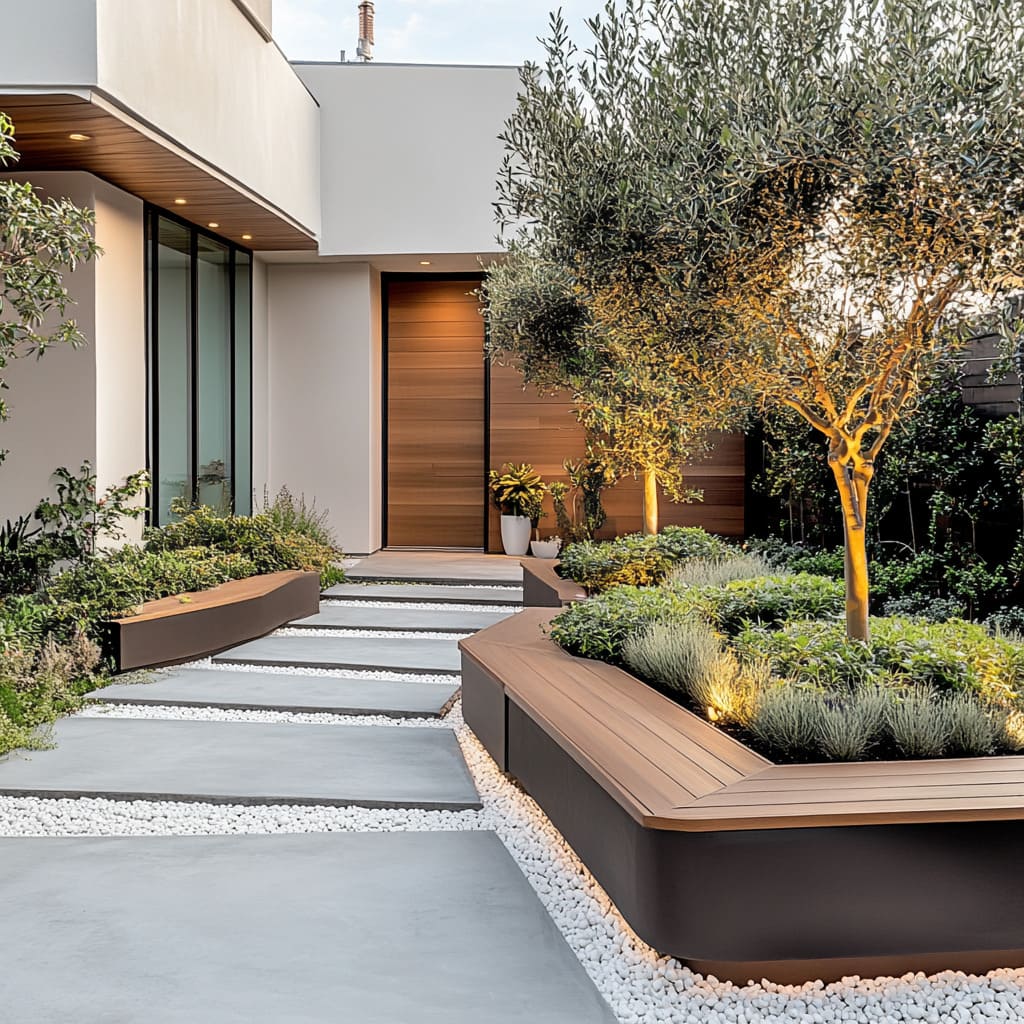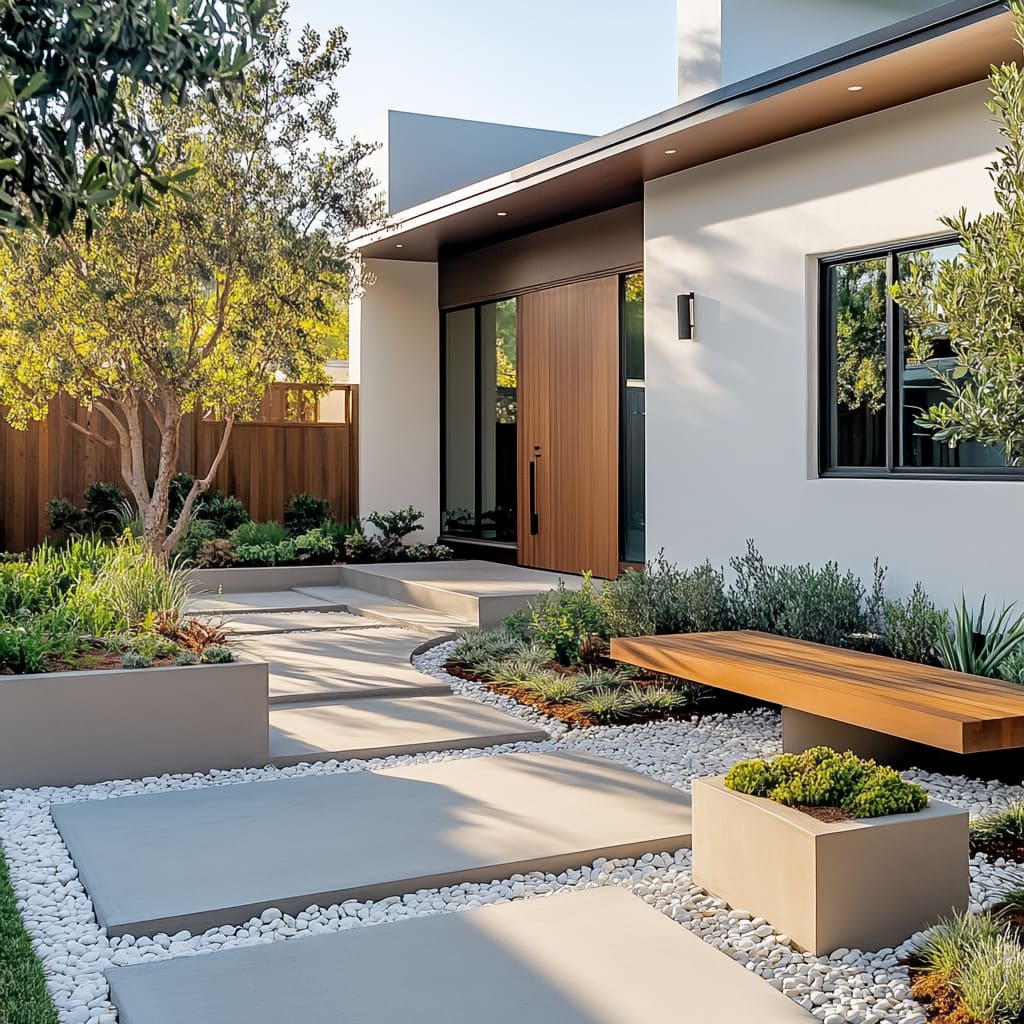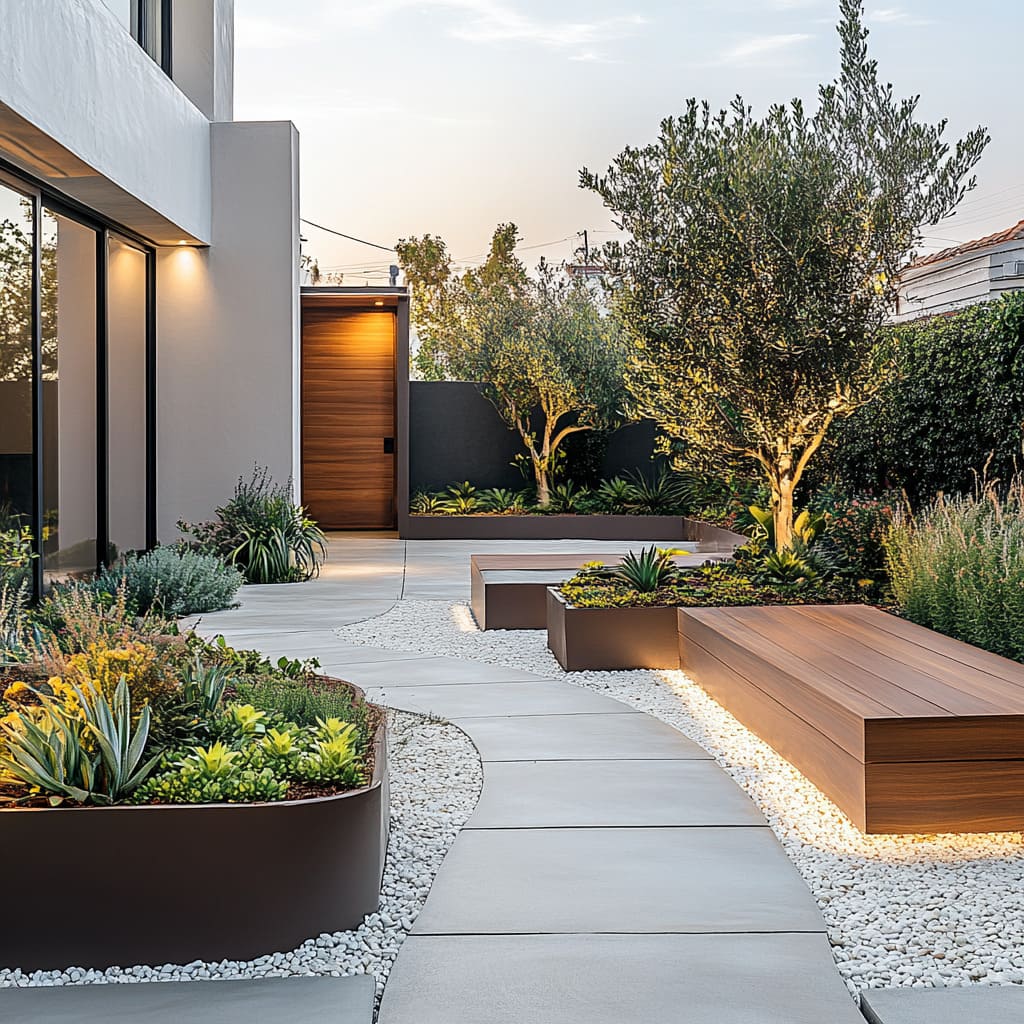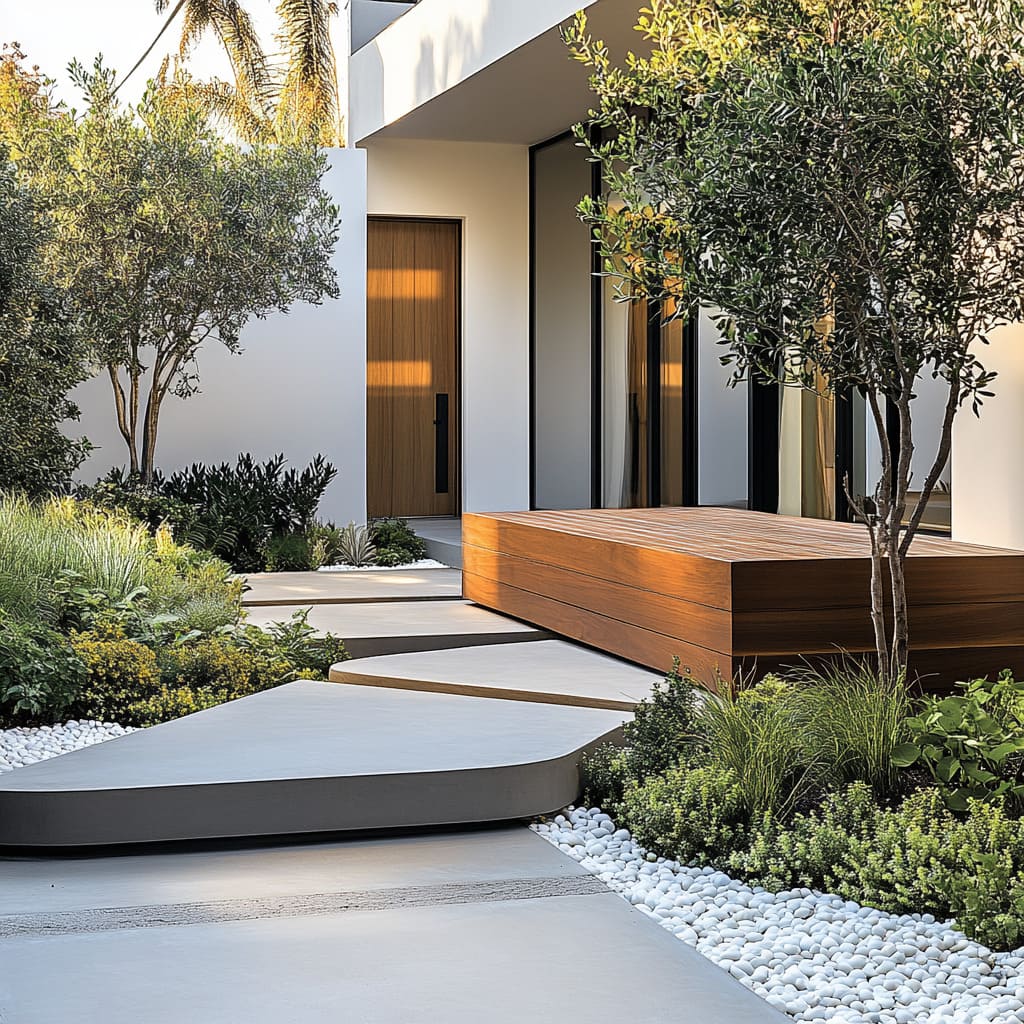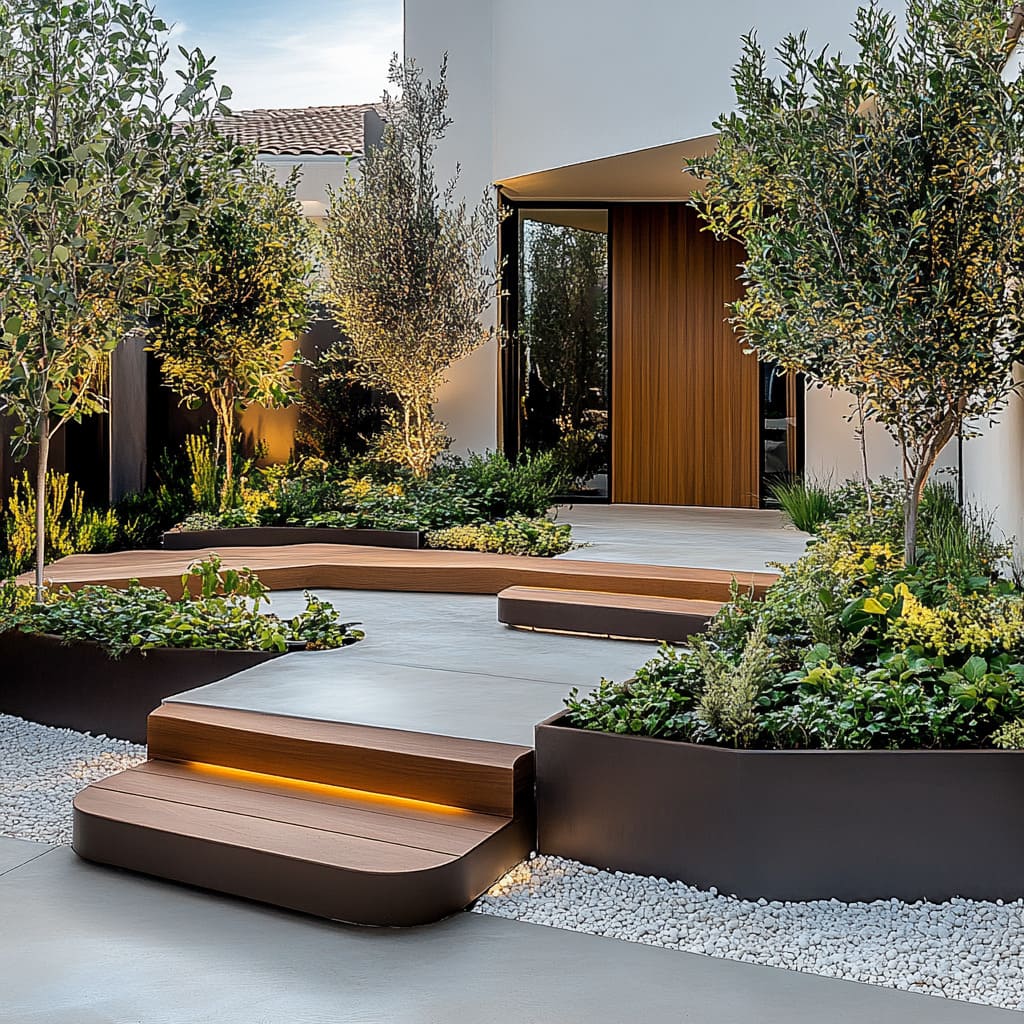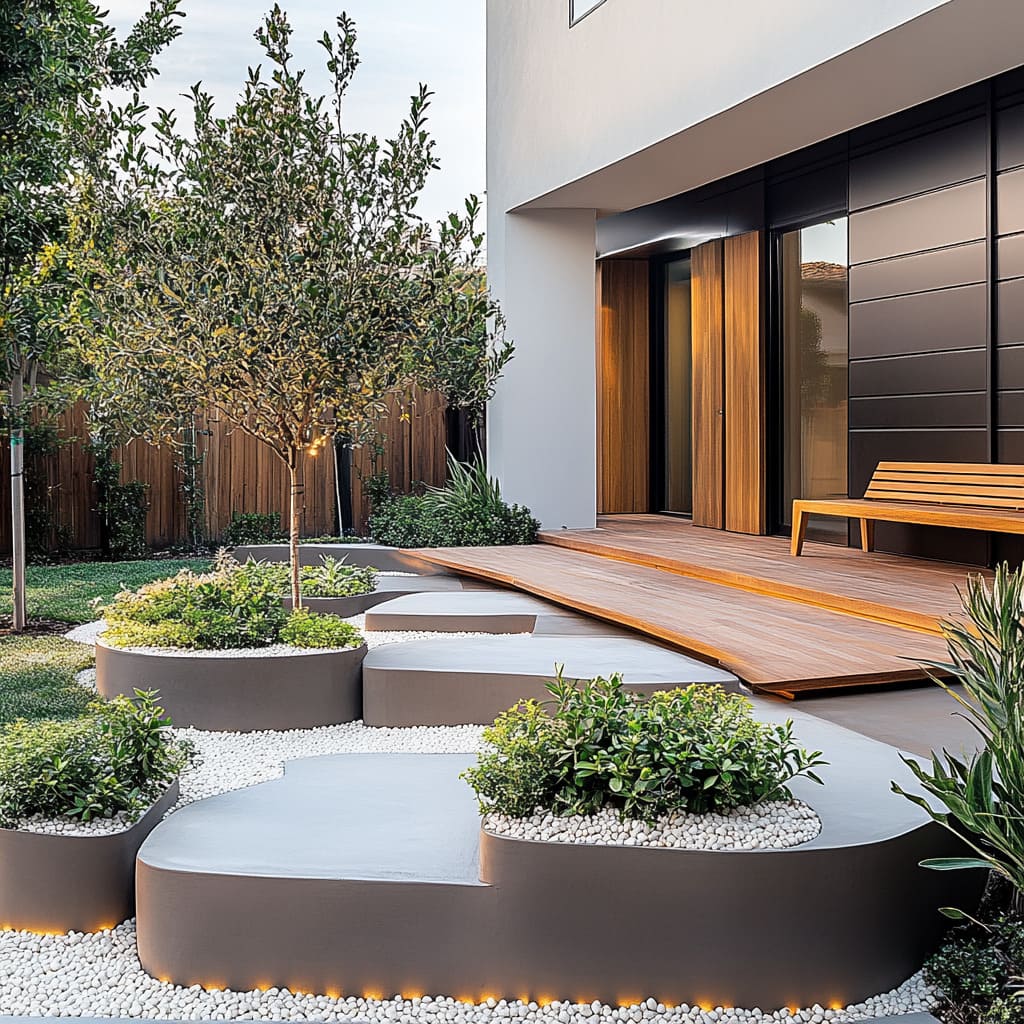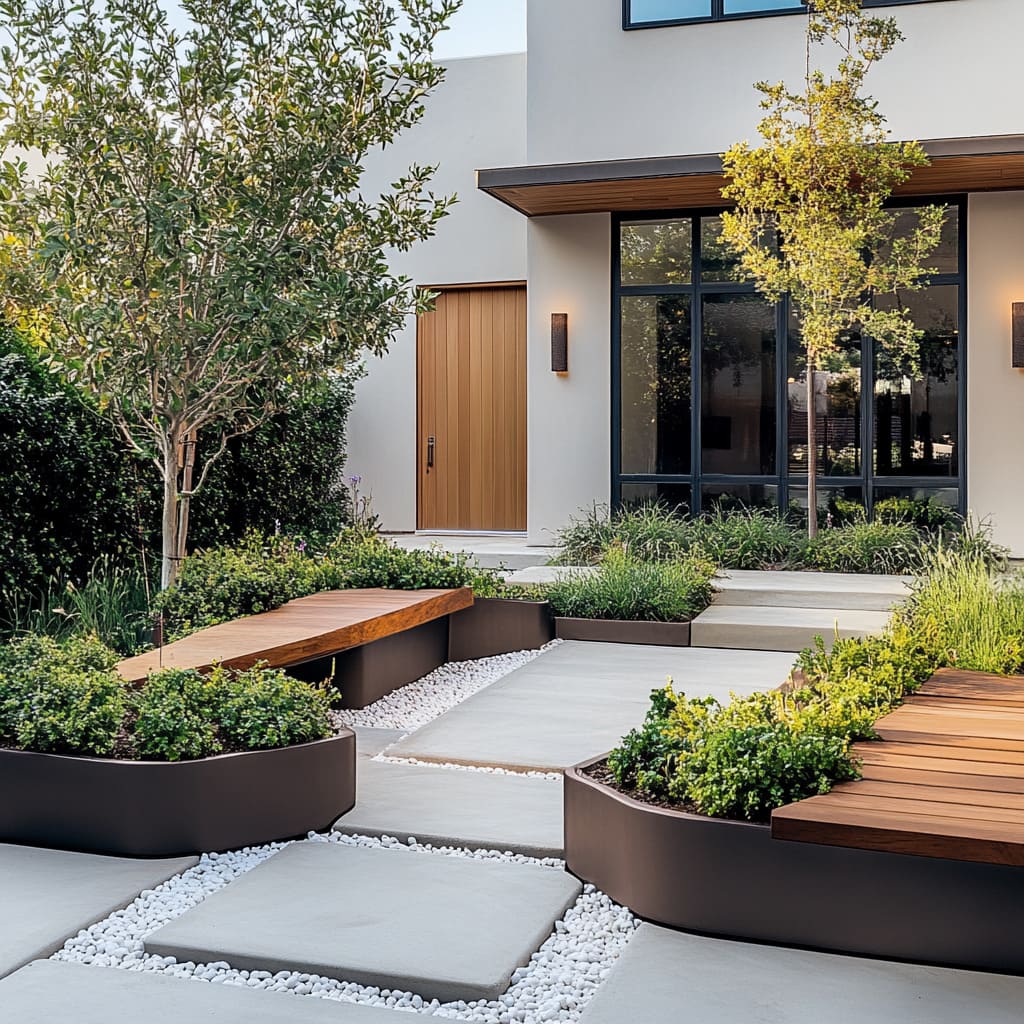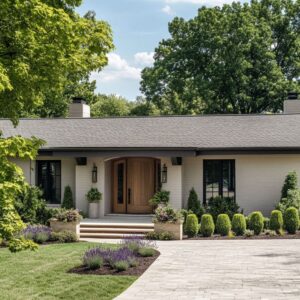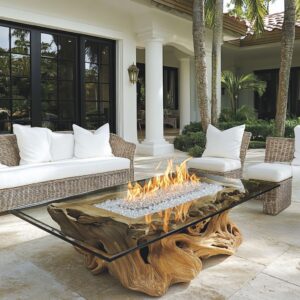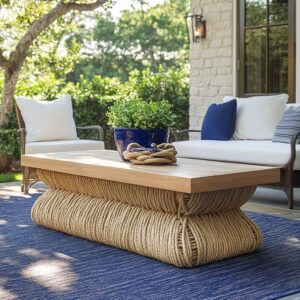Creating a modern front yard that reflects your home’s style while serving as a welcoming and functional space has become an essential aspect of landscaping. Today’s modern front yard landscaping ideas merge clean, structured designs with natural elements, resulting in spaces that balance aesthetic appeal with everyday practicality.
This article dives into inspiring examples of modern front yard designs, highlighting their unique styles, practical solutions, and the creative use of materials and plants. These yards don’t just focus on appearance; they are thoughtfully crafted to enhance curb appeal and make the most of the space.
From sleek pathways that naturally guide visitors to subtle lighting that highlights key features, each design offers fresh ideas tailored for American homes. Whether you’re exploring ideas to refresh your yard or looking for inspiration rooted in contemporary trends, these examples provide insight into creating a front yard that feels harmonious, functional, and timeless.
Design Style: Modern Minimalism with Organic Touches
Modern front yard designs embrace a style that balances simplicity with natural elements, achieving a seamless blend of structure and softness. At the heart of these designs is modern minimalism, where clean lines and geometric layouts create order and sophistication.
However, to prevent these spaces from feeling cold or overly rigid, organic touches are thoughtfully introduced. This combination transforms front yards into spaces that feel refined yet approachable.
One of the key principles is the balance between rigidity and softness. Straight edges in planters, pathways, and benches establish a strong foundation, while curved slab arrangements and the natural flow of plantings add fluidity and movement.
For example, a modern concrete front yard often combines bold, structured elements like rectangular slabs with curved pathways filled with pebbles, creating a striking yet welcoming contrast. Another defining feature is material neutrality, which ties the entire design together.
Neutral tones in concrete, metal planters, and white pebbles set a timeless base, while warm wood accents and vibrant greenery introduce depth and visual interest. This thoughtful pairing of materials ensures that the yard remains visually balanced without overwhelming the overall aesthetic.
To soften the modern aesthetic, subtle warmth is introduced through the use of natural wood. Wooden benches, deck elements, and even planters bring a welcoming tone that contrasts with the cool, industrial feel of concrete and metal.
These details also connect beautifully with broader themes, such as blending indoor and outdoor spaces. For inspiration, these designs align perfectly with modern porch ideas, where functional features like seating areas integrate seamlessly into the front yard.
By layering simplicity with nature, these front yards achieve a harmony that resonates with contemporary homeowners. The combination of geometric precision and organic charm ensures these spaces are not only stylish but also inviting.
Functional and Aesthetic Solutions
Modern front yards are designed to be as practical as they are visually appealing, proving that functionality and artistry can go hand in hand. These spaces prioritize usability without compromising their polished look, making them inviting for both residents and visitors alike.
A standout feature is the thoughtful approach to pathway designs. Concrete slabs, carefully spaced with precision, create a rhythm that feels natural and intuitive.
These slabs are often set in a bed of crisp white pebbles, which serve multiple purposes: they enhance drainage, prevent water from pooling, and provide a clean contrast to the muted tones of the concrete. This arrangement not only guides movement seamlessly but also adds a subtle elegance to the overall layout.
Seating integration further highlights how form meets function in these yards. Built-in wooden benches are not just places to sit—they act as sculptural accents that bring warmth to the space.
These benches, often paired with planters, help break up the harder lines of concrete and metal while providing practical usability. Their streamlined designs ensure they fit seamlessly into the yard, maintaining the minimalist aesthetic while creating a spot to pause and enjoy the surroundings.
Lighting is another element where function elevates design. From LED strip lights subtly placed beneath benches to uplights that showcase the beauty of trees and shrubs, the integration of lighting is both strategic and unobtrusive.
Recessed pathway lights enhance safety while giving the entire yard a welcoming glow during the evening. These thoughtful lighting solutions not only add depth to the space but also create a stunning ambiance that highlights its best features.
For those looking for low-maintenance front yard landscaping, these designs are a perfect fit. The combination of durable materials like concrete and wood with drought-tolerant plants ensures the yard stays beautiful without demanding constant care.
Elements like white pebble drainage and long-lasting LED lighting keep maintenance simple, leaving more time to enjoy the yard’s beauty. These solutions showcase how a functional yard doesn’t have to sacrifice style.
The marriage of practical features with artistic design makes these modern front yards a blueprint for balance and sophistication.
Prominent Design Elements
The success of modern front yard designs lies in the careful selection and combination of elements that not only serve a purpose but also enhance the space’s aesthetic. These elements define the character of the yard, ensuring it feels inviting, balanced, and visually engaging.
Pathways take center stage in these designs, often crafted with irregular concrete slab arrangements. This asymmetry brings a sense of movement and dynamism to the layout, avoiding the rigid, sterile feel that overly structured designs can create.
The spaces between the slabs, filled with crisp white pebbles, provide texture and contrast, while also ensuring practical benefits like better drainage and erosion control. These pathways naturally guide the eye and footsteps through the yard, creating a seamless flow.
Planters play a key role in framing the yard and adding structure. Raised planters with clean edges, whether curved or straight, create depth and help delineate different areas.
Dark-toned metal planters bring a bold, contemporary feel, while lighter taupe finishes offer a softer touch that contrasts beautifully with vibrant greenery. These features are an excellent choice for homeowners seeking low-maintenance flower bed ideas front of house, as the raised design not only protects plants but also minimizes soil spillage and weed growth.
The greenery in these yards is selected for its visual impact and ease of care. Olive trees, with their elegant silvery foliage, stand as focal points, while ornamental grasses and succulents fill out the space with texture and year-round color.
These plants are ideal for their sculptural qualities and drought-resistant nature, ensuring the yard stays lush with minimal effort.
A consistent use of materials ties everything together. Concrete, white pebbles, wood, and metal create a balanced palette that feels both modern and timeless.
The cool, industrial tones of concrete and metal are softened by the natural warmth of wood and the brightness of pebbles, ensuring the space never feels overly stark. These materials are also incredibly durable, making them ideal for long-term outdoor use.
For those considering a modern porch design, these elements can seamlessly extend to the porch area, creating a cohesive flow between the front yard and the home’s entry. Features like raised planters, layered greenery, and clean concrete pathways easily translate into porch aesthetics, adding depth and sophistication.
By focusing on these prominent design elements, modern front yards achieve a perfect balance of form and function. Each piece contributes to the overall harmony of the space, creating a yard that is not only beautiful but also practical and welcoming.
Emerging Trends in Front Yard Design
Modern front yards are evolving to reflect the priorities of today’s homeowners, blending sustainability, functionality, and seamless design. These yards incorporate features that are as practical as they are visually engaging, aligning with contemporary landscaping demands.
A key trend is low-maintenance landscaping, which emphasizes designs that require minimal effort while delivering maximum impact. Drought-resistant plants such as olive trees, succulents, and ornamental grasses thrive in these spaces, reducing water usage and upkeep.
Weatherproof materials like concrete and metal ensure the yard’s durability, while features like pebble-filled drainage systems help manage water effectively. For homeowners searching for low-maintenance front yard ideas, these solutions offer a perfect balance of practicality and style.
Integrated lighting is another standout trend. Rather than relying on bulky fixtures that distract from the design, these yards use subtle lighting techniques to enhance ambiance and functionality.
Recessed pathway lights guide movement while blending into the hardscape. Uplights on trees and shrubs highlight textures, creating depth and drama during evening hours.
These thoughtful placements ensure the yard remains captivating day and night.
Functional hardscapes take the spotlight in many modern front yards. Raised planters serve not only as containers for greenery but also as dividers that define spaces.
Wooden benches double as seating and sculptural focal points, blending seamlessly with the rest of the design. Decks and pathways crafted from concrete and wood provide durable surfaces that tie the yard together, enhancing both usability and aesthetics.
Finally, the trend of seamless indoor-outdoor transitions is gaining traction. The materials, tones, and layout of these yards often echo the home’s interior design, creating continuity between the spaces.
For instance, the use of warm wood tones and minimalist planters in a front yard mirrors similar features in modern interiors, enhancing the flow between outdoor and indoor areas. This approach is particularly suited for those seeking a contemporary front garden that feels like an extension of their living space.
These emerging trends illustrate how modern front yards are designed to adapt to both lifestyle needs and environmental considerations. They provide homeowners with spaces that are not only stylish but also functional, sustainable, and easy to maintain.
Simple Design Principles To Use
Modern front yards are more than just beautiful—they are carefully planned using simple yet effective design principles that bring harmony, balance, and cohesion to outdoor spaces. These principles ensure that every element works together seamlessly, creating a space that feels both dynamic and welcoming.
Symmetry and asymmetry play a key role in creating visual interest. While benches and planters often follow symmetrical lines to anchor the design, pathways introduce asymmetry through irregular shapes and spacing.
This contrast between order and spontaneity makes the space feel structured without being overly rigid. For those exploring modern small front porch ideas, incorporating these contrasting elements can help achieve a balance that feels spacious and inviting, even in compact areas.
Contrast is another principle that adds depth and character. Light materials like white pebbles stand out against darker features such as metal planters, creating striking visual breaks.
At the same time, the addition of warm wood tones helps soften the cooler concrete and metal, creating a blend of textures that feels natural yet refined. This balance of tones ensures the yard doesn’t feel cold or monotonous, adding subtle layers of warmth and comfort.
Repetition is used thoughtfully to create a cohesive flow throughout the yard. Elements like concrete slabs, wooden details, and recurring plant types tie the design together without feeling repetitive.
This careful repetition prevents visual clutter and ensures the space remains easy on the eyes while maintaining its modern aesthetic. Proportion and scale are critical to the success of these designs.
Benches, planters, and pathways are carefully sized to complement the scale of the house and yard. For example, in modern front landscaping, raised planters are often designed to be wide enough to define spaces yet low enough to maintain an open and airy feel.
Similarly, the size of the pathways ensures functionality while contributing to the overall flow of the space. These straightforward principles are easy to adapt and can elevate any front yard into a modern, stylish space.
Whether you’re working with a compact yard or a larger landscape, applying these ideas ensures a balanced design that looks effortless and feels inviting.
Innovative Ideas
Modern landscaping continues to push boundaries, and these front yard designs introduce fresh, creative ideas that can transform any outdoor space into a visually striking and highly functional area. From dynamic features to thoughtful details, these concepts open new possibilities for enhancing curb appeal.
Floating features, such as benches and planters, offer a unique way to add depth and dimension to the design. By slightly elevating these elements, the yard feels lighter and more open, while still maintaining their functionality.
Floating benches, for example, double as seating while creating a sleek and modern visual effect, perfectly suited for a contemporary front yard design. Dynamic pathways take traditional walkway designs to the next level.
Instead of uniform slabs, experimenting with various sizes, shapes, and placements introduces an organic rhythm to the layout. These irregular arrangements not only guide movement naturally but also add energy and creativity to the space.
The interplay of slab designs with surrounding materials like white pebbles creates a visual flow that feels alive and engaging.
Functional pebbles have evolved from simple fillers to integral design elements. Using pebbles as decorative drainage along pathways or integrating them into pebble streams brings both practicality and elegance to the yard.
Pebble-based planter bases are another innovative way to create clean edges and define spaces while enhancing drainage—a smart choice for areas with varying weather conditions. Layered greenery is essential for adding depth and texture to modern yards.
Combining vertical elements like trees with mid-level shrubs and low-growing ground covers ensures visual interest throughout the year. This layering technique helps create structured landscapes that feel lush without overwhelming the design.
In addition, it aligns with trends in sustainable planting, reducing water consumption while maintaining vibrant aesthetics. These forward-thinking ideas are not only visually impactful but also highly adaptable to different yard sizes and styles.
Whether you’re updating an existing space or planning a new layout, incorporating these features ensures a front yard that feels contemporary, functional, and memorable.
Conclusion
Modern front yard designs showcase the potential of thoughtful landscaping to transform even the simplest materials into spaces that are both functional and visually captivating. These yards demonstrate how combining clean lines, natural textures, and strategic elements can create outdoor areas that are easy to maintain while enhancing a home’s overall appeal.
By blending practical features like drought-resistant plants, subtle lighting, and durable materials with artistic touches, these designs offer inspiration for homeowners aiming to balance beauty and usability. Whether it’s a pathway framed by greenery or planters doubling as structural elements, each yard reflects a creative approach to outdoor living.
For those seeking a low maintenance front garden design, these concepts provide clear and achievable ideas that prioritize style without sacrificing ease of care. Ultimately, these designs prove that modern landscaping is about more than appearances.
It’s about creating harmony between the home and its surroundings, offering spaces that are inviting, sustainable, and timeless. With these principles in mind, any front yard can become a standout feature of the home.
